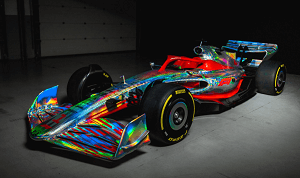F1 Cars Designed to Promote Better Racing
Drivers complained about the ‘dirty air’ churned from the lead car, resulting in a significant loss of downforce for the chasers.
F1 machines are losing up to 35% of downforce when running 20 metres behind the leader and up to 47% at 10 metres.
So, the overriding aim of the 2022 F1 regulations is to encourage more overtaking maneuvers by allowing closer racing.
The Formula 1 Motorsports team collaborated with the FIA to develop an aerodynamic phenomenon referred to as ‘ground effect’ for the 2022 F1 car.
In a nutshell, the new shape reduces the previous figures to 4% loss at twenty metres (3 car lengths) and 18% at ten (10) metres.
Wheel Covers and Over-Wheel Winglets
The rules of Formula One motor racing now allow over-wheel winglets for the first time. Another striking feature is the return to wheel covers (not seen since 2009).
Adding wheel covers to the new F1 car shape for 2022 will send greater airflow through the wheels – helping to increase downforce.
The primary purpose of introducing over-wheel winglets is to make them more resilient ‘aerodynamically’. Thus, the outcome for drivers when racing close to other cars will be:
- Better control of the wake coming off the front tyres.
- Having it directed away from the rear wing (traditionally achieved by vortices from the front wing).
Note: The main section explains F1 rules for beginners including what the racing flags mean and how the point system works.
Low-Profile Tyres and 18 Inch Wheels
F1 teams already had opportunities to test the new Pirelli 18″ wheels. As a result, using bigger tyres will reduce overheating – especially in a slide. Also, the use of lower profile tyres creates a welcome reduction in sidewall deflection changes.
Note: Another sports article explains how F1 racing slackened car eligibility rules for demonstration events so teams can demo their current cars.
Formula 1 Changes: Front Wings and Nose
One of the most important feature changes of the 2022 F1 car is an all-new front wing shape with its ground-breaking ‘anti-outwash’ function.
 Thus, the chief role of the new front wing shape is generating consistent downforce and ensuring control of the front wheel wake.
Thus, the chief role of the new front wing shape is generating consistent downforce and ensuring control of the front wheel wake.
The stylish new front wing and nose concept means the wake is not sent outboard anywhere near as bad as the current cars do. So, in the main, it doesn’t spill under the floor as it gets steered to the side of the car body.
Note: Even though Formula One Motorsports team decided against it in the end, they conducted some research into running the F1 2022 car with no front wing.
Rear Wing Creates Rotational Airflow
Formula 1 car changes for 2022 also reveal an important function created by the stylish new rear wing. Its ‘rolled tips’ shape and position create a rotational airflow.
The job is to collect rear wheel wake and then roll it into the flow exiting the diffuser. In simple F1 terms, it forms an invisible wake shaped like a ‘mushroom’.
Producing a narrower wake results in it flowing higher up into the air. The outcome? Cars that are following close behind get to drive through ‘cleaner air’.
There are plans to remove the drag reduction system (DRS) in future Grands Prix. However, DRS will remain on the rear wing throughout the 2022 Formula 1 season.
Note: Read more about the ratification of F1 rules on car aerodynamics to foster closer racing, ease overtaking, and reduce crashes.
New FIA Regulations for Car Fuel
During the 2021 races, F1 regulations have team cars running on fuel that contains 5.75% bio-components. But, the new rule changes will see the bio-component ratio rise to ten percent (10%).
They will achieve it by using the more sustainable ‘E10 fuel’. By coincidence, motorists will also start seeing E10 fuel at petrol stations in the United Kingdom.
Making F1 Cars Safer through Design
Changing to the new generation of Formula One cars in 2022 presents an ideal opportunity to make motor racing even safer.
The front of the chassis needs to absorb 48% energy in impact tests (15% at the rear) along with greater forces in the static ‘squeeze’ checks. Other safety improvements include:
- Heavier tyres that are also more robust.
- Minimum car weight rising by 5% (e.g. up to 790kg from 752kg).
F1 Cars Use Same 1.6-litre Turbo-Hybrid Unit
We already listed all the key changes for the 2022 Formula One car. But, the current 1.6-litre turbo-hybrid units look likely to stay for next season’s racing.
That said, there will be further components added to the fuel system, along with some extra sensors, so the FIA can better monitor the car’s power unit.
Note: The main section contains more news articles about major sporting events including track racing, MotoGP, the English Premier League, and rugby.
Formula One Help Guides
- F1 frequently asked questions (FAQ) with answers.
- FIA rules and regulations PDF
- F1 terminology: 100s of terms from A to Z.
Note: This short video [6:13 seconds] explains how 2022 F1 car design and new aerodynamics promote better racing.

